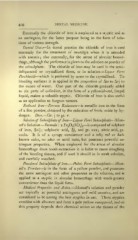Page 408 - My FlipBook
P. 408
406 — DENTAL MEDICINE. —
Externally the chloride of iron is employed as a styptic and as
an astringent, for the latter purpose being in the form of solu-
tions of various strength.
Dental Uses.—In dental practice the chloride of iron is used
internally for the treatment of neuralgia when it is attended
with anemia ; also externally, for the arrest of alveolar hemor-
rhage, although the preference is given to the solution or powder of
the subsulphate. The chloride of iron may be used in the semi-
deliquesced or crystallized form, or in solution Liquor Ferri
Perchloridi—which is preferred by some to the crystallized. To
bleeding surfaces it is applied in the proportion of 5ss to 5vj to
the ounce of water. One part of the chloride gradually added
to six parts of collodion, in the form of a yellowish-red, limpid
liquid, makes a valuable styptic. Chloride of iron is also useful
as an application to fungous tumors.
Reduced Iron— Ferrum Reductutn— is metallic iron in the form
of a fine powder, obtained by the reduction of ferric oxide by hy-
drogen. Dose.—Gr. j to gr. v.
Solution of Subsulphate of Iron— Liquor Ferri Subsulphatis—Mon-
sel's Solution Formula: 2 Fe203(S04)3—is composed of sulphate
of iron, Sxij ; sulphuric acid, 5ji and gr. xxx; nitric acid, gr.
ccclx. It is of a syrupy consistence and a ruby red or dark
brown color, no odor or acrid taste, but possesses powerful as-
tringent properties. When employed for the arrest of alveolar
hemorrhage from tooth-extraction it is liable to cause sloughing
of the bleeding tissues, and if used it should be in weak solution,
and carefully watched.
Powdered Subsulphate of Iron.— Pulvis Ferri Subsulphatis—Mon-
sel's Powder— is in the form of a yellow powder, and possesses
the same astringent and other properties as the solution, and is
applied as a styptic in alveolar hemorrhage with much greater
convenience than the liquid form.
Medical Properties and Action.—Monsel's solution and powder
act topically as powerful astringents and mild caustics, and are
considered to be among the best styptics in use. These styptics
combine with albumen and form a pale yellow compound, and on
this property depends their chemical action on the tissues of the


